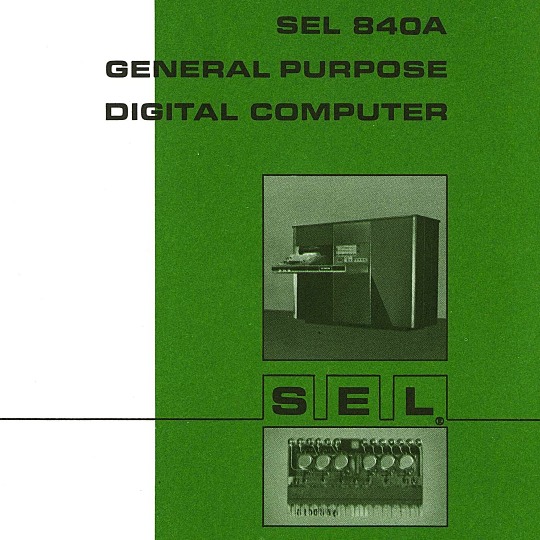#scientificcomputing
Explore tagged Tumblr posts
Text






🎄💾🗓️ Day 11: Retrocomputing Advent Calendar - The SEL 840A🎄💾🗓️
Systems Engineering Laboratories (SEL) introduced the SEL 840A in 1965. This is a deep cut folks, buckle in. It was designed as a high-performance, 24-bit general-purpose digital computer, particularly well-suited for scientific and industrial real-time applications.
Notable for using silicon monolithic integrated circuits and a modular architecture. Supported advanced computation with features like concurrent floating-point arithmetic via an optional Extended Arithmetic Unit (EAU), which allowed independent arithmetic processing in single or double precision. With a core memory cycle time of 1.75 microseconds and a capacity of up to 32,768 directly addressable words, the SEL 840A had impressive computational speed and versatility for its time.
Its instruction set covered arithmetic operations, branching, and program control. The computer had fairly robust I/O capabilities, supporting up to 128 input/output units and optional block transfer control for high-speed data movement. SEL 840A had real-time applications, such as data acquisition, industrial automation, and control systems, with features like multi-level priority interrupts and a real-time clock with millisecond resolution.
Software support included a FORTRAN IV compiler, mnemonic assembler, and a library of scientific subroutines, making it accessible for scientific and engineering use. The operator’s console provided immediate access to registers, control functions, and user interaction! Designed to be maintained, its modular design had serviceability you do often not see today, with swing-out circuit pages and accessible test points.
And here's a personal… personal computer history from Adafruit team member, Dan…
== The first computer I used was an SEL-840A, PDF:
I learned Fortran on it in eight grade, in 1970. It was at Oak Ridge National Laboratory, where my parents worked, and was used to take data from cyclotron experiments and perform calculations. I later patched the Fortran compiler on it to take single-quoted strings, like 'HELLO', in Fortran FORMAT statements, instead of having to use Hollerith counts, like 5HHELLO.
In 1971-1972, in high school, I used a PDP-10 (model KA10) timesharing system, run by BOCES LIRICS on Long Island, NY, while we were there for one year on an exchange.
This is the front panel of the actual computer I used. I worked at the computer center in the summer. I know the fellow in the picture: he was an older high school student at the time.
The first "personal" computers I used were Xerox Alto, Xerox Dorado, Xerox Dandelion (Xerox Star 8010), Apple Lisa, and Apple Mac, and an original IBM PC. Later I used DEC VAXstations.
Dan kinda wins the first computer contest if there was one… Have first computer memories? Post’em up in the comments, or post yours on socialz’ and tag them #firstcomputer #retrocomputing – See you back here tomorrow!
#retrocomputing#firstcomputer#electronics#sel840a#1960scomputers#fortran#computinghistory#vintagecomputing#realtimecomputing#industrialautomation#siliconcircuits#modulararchitecture#floatingpointarithmetic#computerscience#fortrancode#corememory#oakridgenationallab#cyclotron#pdp10#xeroxalto#computermuseum#historyofcomputing#classiccomputing#nostalgictech#selcomputers#scientificcomputing#digitalhistory#engineeringmarvel#techthroughdecades#console
28 notes
·
View notes
Text
ESM3: The AI That's Fast-Forwarding Evolution

In a breakthrough that sounds like science fiction becoming reality, Evolutionary Scale's new AI model ESM3 is accomplishing what typically takes nature hundreds of millions of years - creating entirely new proteins from scratch. This development represents a fundamental shift in how we can manipulate the building blocks of life itself.
The Power of 2.78 Billion Proteins
At its core, ESM3 is a generative AI model trained on an astronomical 2.78 billion proteins. But unlike its predecessors, ESM3 doesn't just analyze protein sequences - it understands their three-dimensional structures and functions, similar to how ChatGPT comprehends language. This comprehensive understanding allows it to design entirely new proteins with specific desired functions.
The GFP Breakthrough: Proof in the Glow
The team behind ESM3 demonstrated its capabilities through a remarkable achievement - creating a completely novel Green Fluorescent Protein (GFP). While GFPs naturally occur in jellyfish and have been used by scientists as cellular markers, ESM3 designed an entirely new version that has never existed in nature. This achievement effectively compressed what might have taken 500 million years of evolution into mere months of computational work.
Beyond Analysis to Creation
What sets ESM3 apart is its ability to go beyond analyzing existing proteins to generating new ones with specific functions. The process mirrors modern AI language models but instead of working with words and sentences, ESM3 works with the complex language of protein structures and functions. When asked to create proteins with specific properties, it can generate multiple candidates and iterate based on feedback, leading to novel proteins with desired characteristics.
Real-World Applications
The implications of ESM3's capabilities are staggering: - Drug Discovery: The potential to design proteins that can target specific disease pathways with unprecedented precision, leading to more effective treatments with fewer side effects - Personalized Medicine: The ability to create treatments tailored to individual genetic profiles - Materials Science: Development of new biomaterials with specific properties for applications ranging from sustainable packaging to advanced electronics - Environmental Solutions: Potential to create proteins that could efficiently capture carbon dioxide from the atmosphere - Synthetic Biology: New possibilities in designing biological systems for various applications
Democratizing Protein Design
Perhaps most importantly, Evolutionary Scale is making ESM3 accessible to the broader scientific community. Through: - An open-source version for researchers - A closed beta API for specific applications - Partnerships with AWS and NVIDIA for wider availability This commitment to accessibility could accelerate scientific discovery across multiple fields.
Looking to the Future
While ESM3 represents a significant breakthrough, it's likely just the beginning of what's possible in protein engineering. As one researcher noted, "ESM3 is like the Model T of protein engineering - we can expect to see the equivalent of Ferraris and spaceships in the not-too-distant future."
Navigating the Challenges
This powerful technology also raises important considerations: - The need for careful safety protocols in protein design - Ethical considerations around manipulating biological systems - Potential risks of misuse - The importance of responsible development and application

Conclusion
ESM3 represents a fundamental shift in our ability to understand and manipulate the building blocks of life. As we stand at this frontier of biological engineering, the potential for breakthrough discoveries in medicine, materials science, and environmental protection is enormous. While the technology must be developed responsibly, ESM3 marks a significant step toward making biology programmable - opening up possibilities that were previously confined to the realm of science fiction. View the original White Paper by clicking or scanning the QR Code. Read the full article
#AIFramework#BiologicalProgramming#BiomolecularEngineering#ComputationalBiology#DrugDiscoveryAI#EvolutionaryComputing#GenerativeBiology#MachineLearningBiology#MolecularDesign#ProteinDesignAI#ProteinEngineering#ProteinFolding#ScientificComputing#SyntheticBiology#TherapeuticProteinDesign
0 notes
Text
Quantum-centric supercomputing for materials science represents a transformative approach to computational research, aiming to leverage the power of quantum computing to solve complex problems in material design and discovery. Contact For Enquiries: [email protected] Get Connected Here ---------------------- ---------------------- Instagram: www.instagram.com/amophysicsawards/ Facebook: www.facebook.com/profile.php?id=100092029748922 twitter: twitter.com/home pinterest: in.pinterest.com/physicsresearch2000/ blogger: www.blogger.com/u/5/blog/posts/4758468583908890312?pli=1 #QuantumComputing #Supercomputing #MaterialsScience #QuantumMaterials #QuantumTechnology #ComputationalScience #QuantumSimulations #QuantumAlgorithms #HighPerformanceComputing #QuantumFuture #MaterialDesign #QuantumPhysics #QuantumResearch #QuantumCentric #ScientificComputing #QuantumModeling #QuantumChallenges #NextGenComputing #QuantumInnovation #MaterialsResearch #QuantumEngineering #QuantumAdvancements #SupercomputerTech #QuantumMechanics #QuantumPotential #EmergingTechnologies #QuantumSimulations #QuantumTheory #QuantumRevolution #MaterialsInnovation
1 note
·
View note
Photo

Top 10 Best Laptop For Scientific Computing – Available Now
I hope it will help you to take final decision for Best Laptop For Scientific Computing.
1 note
·
View note
Link
0 notes
Text
#AppliedPhysics2019 #Savethedate October 16-17, 2019 || #SingaporeCity, Singapore All set at #Singapore to witness the recent trends and innovations in the fields of #physics and #mathematics Join hands to make this world better by sharing your research and communicating with eminent professionals at #AppliedPhysics2019 #Learn #Network #Share Learn more: https://urlzs.com/c182C Know about speakers:https://urlzs.com/b8xVv Mail:[email protected] Call/Whatsapp: +65-31581626
#Astrophysics#QuantumPhysics#NanoPhysics#NanoTechnology#AppliedProbability#ComputationalMathematics#ScientificComputing#NuclearPhysics#AtomicPhysics#molecular physics
0 notes
Text
Fully-Funded PhD Positions Institute of Science and Technology Austria - ISTA Application Deadline: 2023-01-08 Fully-funded PhD positions in Biology, Computer Science, Chemistry & Materials, Data Science & Scientific Computing, Mathematics, Neuroscience, and Physics The Institute of Science and Techno... See the full job description on jobRxiv: https://jobrxiv.org/job/institute-of-science-and-technology-austria-ista-27778-fully-funded-phd-positions/?feed_id=27494 #ScienceJobs #hiring #research #ISTAresearch #ISTAustria #PhDcall #biology #chemistry #materials #neuroscience #mathematics #computerscience #physics #datascience #scientificcomputing #phd #research #basicresearch
0 notes
Link
Download Applied Signal Processing: A MATLAB-Based Proof of Concept PDF #9783540208525 #Computers #Software;Systems;scientificcomputing...
0 notes
Photo

When you have sh*t to do and you watch way too much The Office... You create: Mega-Desk. Thank you Dwight Schrute. ✊🏽😔 lol. 😂😁😜 #theoffice #computerprogrammer #dwightschrute #megadesk #vizio #music #matlab #scientificcomputing
1 note
·
View note
Text
Evolutionary Scale Model 3

ESM3: The AI That's Revolutionizing Protein Design
The Minds Behind the Innovation
Evolutionary Scale, a groundbreaking AI research lab that emerged in 2023, stands at the forefront of computational biology. The team behind ESM3 brings impressive credentials, having previously developed ESM1 at Meta (Facebook). This wasn't just a new company entering the field - it was a team of veteran researchers and engineers who had already proven their expertise in protein language models. Their vision caught the attention of major investors, securing $142 million in funding, demonstrating the technology industry's confidence in their approach to making biology programmable through AI. A New Frontier in Protein Engineering ESM3 represents a fundamental leap forward in artificial intelligence for biological design. At its core, it's a generative AI model trained on an astronomical 2.78 billion proteins - but calling it just a protein database would be like calling ChatGPT a dictionary. ESM3 understands proteins in three crucial dimensions: - Sequence: The basic "code" of amino acids that make up proteins - Structure: The complex 3D shapes that proteins fold into - Function: The actual roles these proteins play in biological systems What sets ESM3 apart is its ability to not just analyze existing proteins but to create entirely new ones from scratch. This generative capability allows it to design proteins that have never existed in nature but serve specific desired functions. The Timeline of Innovation The journey of ESM3 began with its predecessors at Meta, where the team developed the original ESM1 model. After establishing Evolutionary Scale in 2023, the team worked to push the boundaries of what was possible in protein design. The result was ESM3, which emerged as a powerful tool for protein engineering, capable of compressing what would take nature hundreds of millions of years of evolution into months of computational work. From ESM3 Lab to Real World ESM3's impact extends far beyond the laboratory. The technology is being deployed across multiple platforms through partnerships with AWS and NVIDIA, making it accessible to researchers and companies worldwide. The framework operates in both academic and commercial settings, with applications ranging from pharmaceutical laboratories to environmental research facilities. More importantly, Evolutionary Scale has committed to democratizing access to this technology through: - An open-source version for researchers - A closed beta API for specific applications - Cloud-based deployment options - Partnerships with major technology providers The Transformative Potential The development of ESM3 addresses several crucial needs in modern science and technology: Medical Breakthroughs ESM3's ability to design precise, targeted proteins opens new possibilities in drug development and personalized medicine. Rather than relying on traditional trial-and-error methods, researchers can now design proteins specifically tailored to target disease pathways with unprecedented precision. Environmental Solutions The technology's potential extends to environmental challenges, with the ability to design proteins that could efficiently capture carbon dioxide or break down pollutants. This could provide new tools in the fight against climate change and environmental degradation. Materials Science Innovation ESM3's capabilities in protein design extend to the development of new biomaterials, potentially revolutionizing fields from sustainable packaging to advanced electronics. Accelerating Scientific Discovery By compressing evolutionary timescales from millions of years to months, ESM3 dramatically accelerates the pace of biological innovation. This acceleration could lead to breakthroughs in fields that traditionally required extensive trial-and-error experimentation.
The Proof: The GFP Breakthrough
The team demonstrated ESM3's capabilities through a remarkable achievement - creating a novel Green Fluorescent Protein (GFP) that had never existed in nature. While GFPs naturally occur in jellyfish and have been used by scientists as cellular markers, ESM3 designed an entirely new version with unique properties. This achievement effectively demonstrated the model's ability to not just understand but to innovate in protein design.
Looking Ahead: The Future of Biological Engineering
ESM3 represents more than just a technological advancement - it's a fundamental shift in how we approach biological engineering. As researchers and companies begin to explore its capabilities, we're likely to see applications that we haven't even imagined yet. The technology raises important questions about the future of biological engineering and our ability to design life's building blocks. While the potential benefits are enormous, Evolutionary Scale maintains a commitment to responsible development, ensuring that this powerful technology is used ethically and safely. As we stand at this frontier of biological engineering, ESM3 marks a significant step toward making biology programmable - opening up possibilities that were previously confined to the realm of science fiction. Whether it's developing new treatments for diseases, creating sustainable materials, or finding solutions to environmental challenges, ESM3 is poised to play a crucial role in shaping our technological future.
Conclusion
ESM3 represents a convergence of artificial intelligence and biological understanding that could fundamentally transform how we approach some of humanity's biggest challenges. As the technology continues to develop and more researchers and organizations gain access to its capabilities, we're likely to see an acceleration in biological innovation that could reshape multiple industries and scientific fields. Read the full article
#AIFramework#BiologicalProgramming#BiomolecularEngineering#ComputationalBiology#DrugDiscoveryAI#EvolutionaryComputing#GenerativeBiology#MachineLearningBiology#MolecularDesign#ProteinDesignAI#ProteinEngineering#ProteinFolding#ScientificComputing#SyntheticBiology#TherapeuticProteinDesign
0 notes
Link
Download Linear Programming with MATLAB (MPS-SIAM Series on Optimization) PDF #9780071510301 #Computers #Software;Systems;scientificcomputing...
0 notes
Link
Download ANSYS Workbench Tutorial PDF #9789048137466 #Computers #Software;Systems;scientificcomputing...
0 notes
Link
Download Solving ODEs with MATLAB PDF #9780521008594 #Computers #Software;Systems;scientificcomputing...
0 notes
Link
Download Introduction to Mathematica® for Physicists PDF #9781461423867 #Computers #Software;Systems;scientificcomputing...
0 notes
Link
Download Negative binomial regression PDF #9780761944515 #Computers #Software;Systems;scientificcomputing...
0 notes
Link
Download Dynamical Systems with Applications using Mathematica® PDF #9780387368269 #Computers #Software;Systems;scientificcomputing...
0 notes